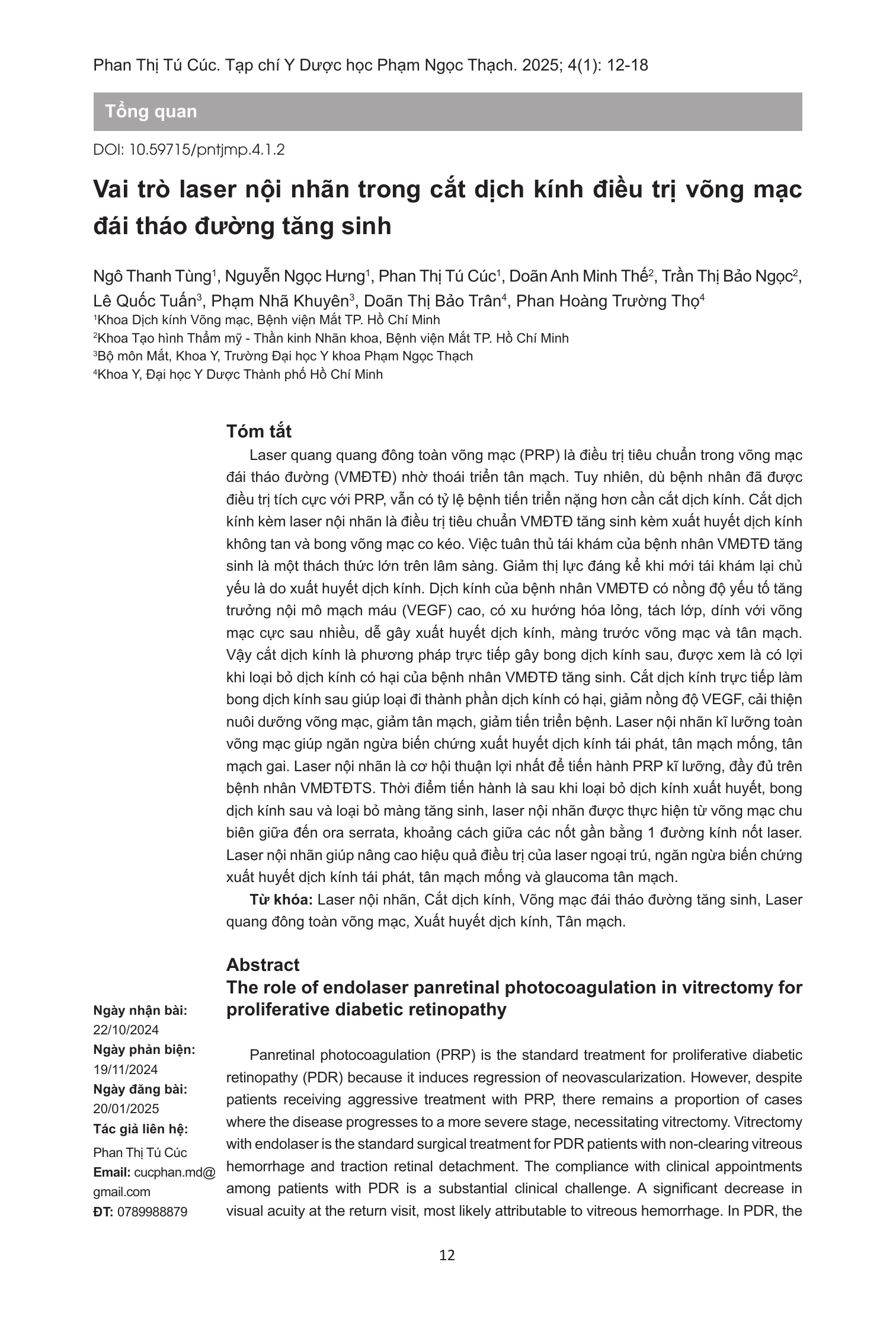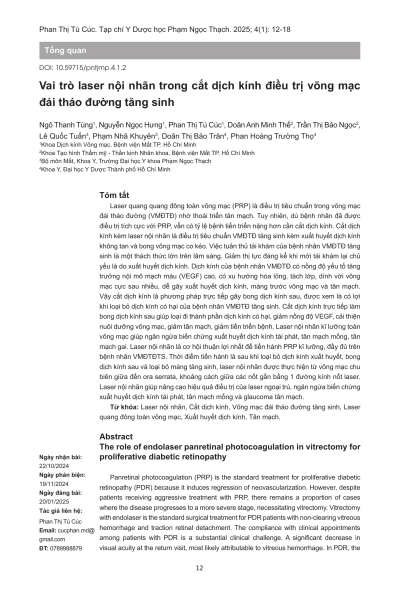Tuy nhiên, dù bệnh nhân đã được điều trị tích cực với PRP, vẫn có tỷ lệ bệnh tiến triển nặng hơn cần cắt dịch kính. Cắt dịch kính kèm laser nội nhãn là điều trị tiêu chuẩn VMĐTĐ tăng sinh kèm xuất huyết dịch kính không tan và bong võng mạc co kéo. Việc tuân thủ tái khám của bệnh nhân VMĐTĐ tăng sinh là một thách thức lớn trên lâm sàng. Giảm thị lực đáng kể khi mới tái khám lại chủ yếu là do xuất huyết dịch kính. Dịch kính của bệnh nhân VMĐTĐ có nồng độ yếu tố tăng trưởng nội mô mạch máu (VEGF) cao, có xu hướng hóa lỏng, tách lớp, dính với võng mạc cực sau nhiều, dễ gây xuất huyết dịch kính, màng trước võng mạc và tân mạch. Vậy cắt dịch kính là phương pháp trực tiếp gây bong dịch kính sau, được xem là có lợi khi loại bỏ dịch kính có hại của bệnh nhân VMĐTĐ tăng sinh. Cắt dịch kính trực tiếp làm bong dịch kính sau giúp loại đi thành phần dịch kính có hại, giảm nồng độ VEGF, cải thiện nuôi dưỡng võng mạc, giảm tân mạch, giảm tiến triển bệnh. Laser nội nhãn kĩ lưỡng toàn võng mạc giúp ngăn ngừa biến chứng xuất huyết dịch kính tái phát, tân mạch mống, tân mạch gai. Laser nội nhãn là cơ hội thuận lợi nhất để tiến hành PRP kĩ lưỡng, đầy đủ trên bệnh nhân VMĐTĐTS. Thời điểm tiến hành là sau khi loại bỏ dịch kính xuất huyết, bong dịch kính sau và loại bỏ màng tăng sinh, laser nội nhãn được thực hiện từ võng mạc chu biên giữa đến ora serrata, khoảng cách giữa các nốt gần bằng 1 đường kính nốt laser. Laser nội nhãn giúp nâng cao hiệu quả điều trị của laser ngoại trú, ngăn ngừa biến chứng xuất huyết dịch kính tái phát, tân mạch mống và glaucoma tân mạch. Abstract Panretinal photocoagulation (PRP) is the standard treatment for proliferative diabetic retinopathy (PDR) because it induces regression of neovascularization. However, despite patients receiving aggressive treatment with PRP, there remains a proportion of cases where the disease progresses to a more severe stage, necessitating vitrectomy. Vitrectomy with endolaser is the standard surgical treatment for PDR patients with non-clearing vitreous hemorrhage and traction retinal detachment. The compliance with clinical appointments among patients with PDR is a substantial clinical challenge. A significant decrease in visual acuity at the return visit, most likely attributable to vitreous hemorrhage. In PDR, the vitreous serves as a reservoir of pathological vascular endothelial growth factor (VEGF), tend to synchesis, vitreoschisis and adhesions in the posterior vitreoretinal region, leading to vitreous haemorrhage, epiretinal membrane formation and retinal neovascularization. As vitrectomy is the most direct form of PVD, it is reasonable to expect it to control DR progression by removing the pathological vitreous, decreasing VEGF concentration in the vitreous cavity, improving the retinal feeding state and reducing neovascularisation. Performing endolaser thoroughly on the retina helps to prevent serious complications. Vitrectomy provides the best opportunity to thoroughly and completely apply endolaser in PDR patients. After removing the hemorrhagic vitreous, peripheral vitreous, and dissecting the proliferative membranes, endolaser is applied to perform PRP from the mid-periphery up to the ora serrata, with the spacing between the spots being approximately a spot diameter. Endolaser enhances the effectiveness of PRP in an outpatient setting, helping to prevent recurrent vitreous hemorrhage and neovascular glaucoma. DOI: 10.59715/pntjmp.4.1.2












Thêm một bài đánh giá
Xếp hạng
Không có bài đánh giá nào!